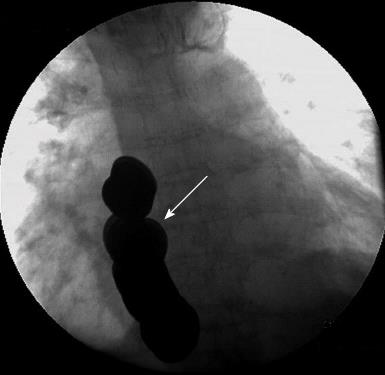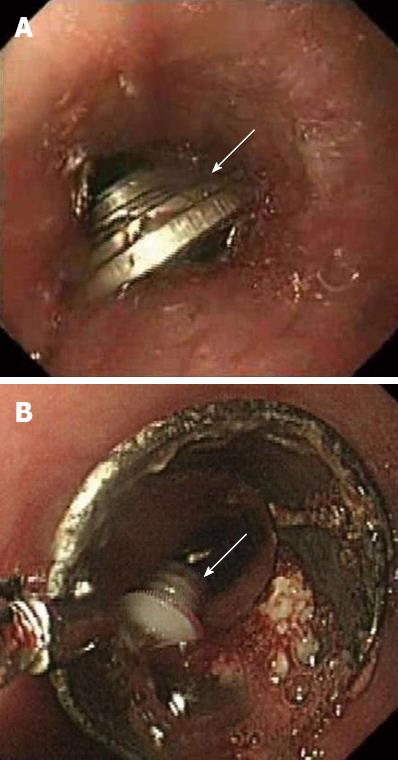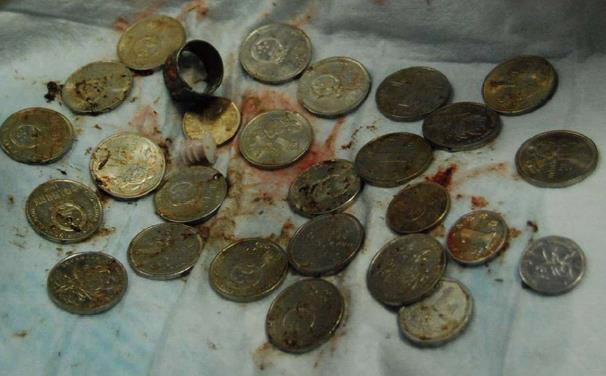Published online Jul 7, 2013. doi: 10.3748/wjg.v19.i25.4091
Revised: April 19, 2013
Accepted: May 17, 2013
Published online: July 7, 2013
Processing time: 127 Days and 20.1 Hours
Foreign body ingestion is a common emergency situation in children with one or a few objects having been ingested. Here we report our experience using endoscopic retrieval in a female centenarian with dyspnea and foreign bodies in the esophagus. She attempted suicide by swallowing 26 coins and two other foreign bodies. A gastroscope was used to remove all foreign bodies in the lower esophagus. In total, 26 coins, one ferrous ring and one cylindrical plastic object were retrieved. To our knowledge, this is the first clinical report on retrieval of so many foreign bodies in a single case.
Core tip: Foreign body ingestion is typically a childhood phenomenon, and generally involves one or a few objects. Here, we report our experience using emergency endoscopy in a centenarian with dyspnea who had swallowed 26 coins and other foreign bodies. Rescue measures were applied to maintain stable vital signs and airway patency, while an alligator forceps or basket was inserted through a flexible gastroscope to remove all foreign bodies. The objects removed from the patient included 26 coins, a ferrous ring, and a cylindrical plastic object.
- Citation: Li QP, Ge XX, Ji GZ, Fan ZN, Zhang FM, Wang Y, Miao L. Endoscopic retrieval of 28 foreign bodies in a 100-year-old female after attempted suicide. World J Gastroenterol 2013; 19(25): 4091-4093
- URL: https://www.wjgnet.com/1007-9327/full/v19/i25/4091.htm
- DOI: https://dx.doi.org/10.3748/wjg.v19.i25.4091
Ingestion of foreign bodies that lodge in the upper gastrointestinal (GI) tract is common. Most objects pass through the GI tract spontaneously, but some need endoscopic or surgical removal. Here, we report the first case of a centenarian who had swallowed several foreign bodies, which were safely removed by endoscopy.
Foreign body ingestion is a commonly encountered clinical problem in pediatric emergency cases, but generally it involves only one or a few objects. Here, we report a case of ingestion of foreign bodies in a centenarian.
A 100-year-old woman complaining of retrosternal pain and tachypnea visited the emergency room. She had swallowed several foreign bodies in a suicide attempt due to intolerable pain induced by a fracture she suffered 3 mo previously. She was bedridden and had a depressed mood, which caused her to attempt suicide. She was admitted to hospital and a routine chest roentgenogram showed the incidental finding of suspicious foreign bodies, which were located in the lower esophagus (Figure 1). Blood tests were normal, and an electrocardiogram showed premature ventricular extrasystole. Further gastroscopy examination using a flexible endoscope under a conscious state showed that several coins were located in the lower esophagus (Figure 2A). Endoscopic removal of these coins was performed, but failed because of their smooth edges. Therefore, an alligator clamp was employed to secure the coins, and more than 10 coins were successfully removed. Additionally, a cylindrical plastic foreign body was difficult to extract using the alligator clamp (Figure 2B). After several attempts, this foreign body was taken out via a stone retrieval net. Subsequently, additional foreign bodies were found and taken out using the alligator forceps. The foreign bodies removed from the patients included 26 coins, a ferrous ring, and a cylindrical plastic object (Figure 3). The procedure took about half an hour. When we reviewed the gastroscopy procedure, there was no block and no active bleeding in the esophagus.
Ingestion of foreign bodies is common in clinical practice. Most foreign body ingestion is accidental, and often occurs in the pediatric population, with a peak incidence between 6 mo and 6 years of age[1]. In contrast to the high frequency of foreign body ingestion in children, the occurrence rate of foreign body ingestion is relatively low in adults. The situation in adults occurs more commonly in patients with psychiatric disorders, mental retardation, or impairment caused by alcohol[2]. This is the first report of a centenarian ingesting foreign bodies in a suicide attempt due to intolerable pain. Additionally, the location of the foreign bodies in this case was in the lower esophagus, which was different from previous reports in which the majority of foreign bodies were located in the upper esophagus[3,4]. Foreign bodies in the upper esophagus may cause mechanical compression of the airway while in the lower esophagus may cause functional narrowing of the cardia. In this case, the patient’s dyspnea was caused by both mechanical compression of the airway and functional narrowing of the cardia because of the irritation of so many foreign bodies.
The type of foreign body may influence the risk of complications. The types of foreign objects are different for different ages and cultures. In children, coins are a common type of foreign body[5]. In Asian countries, bone foreign bodies have been regarded as the most common type due to traditional habits of swallowing fish bones or eating soup from which fish bones are not removed[6,7]. The current case was rare in that a centenarian swallowed the coins.
Endoscopic removal of foreign bodies and impacted food boluses is a reliable and safe procedure in the hands of a skilled endoscopists, and it has a high success rate and low level of significant complications[8]. However, the effectiveness of endoscopic removal of the foreign bodies was challenged by the smooth edges of the coins in the current case. Therefore, an alligator clamp was utilized. Additionally, a stone retrieval net was also employed to extract a cylindrical plastic foreign body in the present case. Many foreign bodies were removed, which is another important point in this case.
According to our experience, the key factor in shortening the procedure time was to catch and remove the foreign bodies in a short time using a powerful retrieval device. If the surface of the foreign body is smooth, it may be much more difficult. Each object is a challenge to the endoscopist. This was the reason why it took us 0.5 h to remove all the foreign bodies using a common stone extraction device. Fortunately, a novel retrieval basket is being developed by Detian Medical (Changzhou, China). Based on our animal and in vitro experiments, it is much easier for an endoscopist to catch foreign bodies and polyps and hold them stably in this basket device compared with traditional retrieval devices.
In conclusion, we reported our experience with retrieval of 26 coins and another two foreign bodies from the esophagus of a 100-year-old suicidal patient with dyspnea. To our knowledge, this is the first clinical report of retrieval of so many foreign bodies in a single case.
P- Reviewers Muguruma N, Tagaya N, Terruzzi V S- Editor Zhai HH L- Editor Cant MR E- Editor Ma S
| 1. | Chinski A, Foltran F, Gregori D, Ballali S, Passali D, Bellussi L. Foreign Bodies in the Oesophagus: The Experience of the Buenos Aires Paediatric ORL Clinic. Int J Pediatr. 2010;2010. [RCA] [PubMed] [DOI] [Full Text] [Full Text (PDF)] [Cited by in Crossref: 26] [Cited by in RCA: 30] [Article Influence: 2.0] [Reference Citation Analysis (0)] |
| 2. | Paul SP, Hawes D, Taylor TM. Foreign body ingestion in children: case series, review of the literature and guidelines on minimising accidental ingestions. J Fam Health Care. 2010;20:200-204. [PubMed] |
| 3. | Webb WA. Management of foreign bodies of the upper gastrointestinal tract: update. Gastrointest Endosc. 1995;41:39-51. [RCA] [PubMed] [DOI] [Full Text] [Cited by in Crossref: 390] [Cited by in RCA: 356] [Article Influence: 11.9] [Reference Citation Analysis (0)] |
| 4. | Mosca S, Manes G, Martino R, Amitrano L, Bottino V, Bove A, Camera A, De Nucci C, Di Costanzo G, Guardascione M. Endoscopic management of foreign bodies in the upper gastrointestinal tract: report on a series of 414 adult patients. Endoscopy. 2001;33:692-696. [PubMed] |
| 5. | Little DC, Shah SR, St Peter SD, Calkins CM, Morrow SE, Murphy JP, Sharp RJ, Andrews WS, Holcomb GW, Ostlie DJ. Esophageal foreign bodies in the pediatric population: our first 500 cases. J Pediatr Surg. 2006;41:914-918. [RCA] [PubMed] [DOI] [Full Text] [Cited by in Crossref: 119] [Cited by in RCA: 95] [Article Influence: 5.0] [Reference Citation Analysis (0)] |
| 6. | Wu WT, Chiu CT, Kuo CJ, Lin CJ, Chu YY, Tsou YK, Su MY. Endoscopic management of suspected esophageal foreign body in adults. Dis Esophagus. 2011;24:131-137. [RCA] [PubMed] [DOI] [Full Text] [Cited by in RCA: 2] [Reference Citation Analysis (0)] |
| 7. | Li ZS, Sun ZX, Zou DW, Xu GM, Wu RP, Liao Z. Endoscopic management of foreign bodies in the upper-GI tract: experience with 1088 cases in China. Gastrointest Endosc. 2006;64:485-492. [RCA] [PubMed] [DOI] [Full Text] [Cited by in Crossref: 173] [Cited by in RCA: 160] [Article Influence: 8.4] [Reference Citation Analysis (0)] |
| 8. | Katsinelos P, Kountouras J, Paroutoglou G, Zavos C, Mimidis K, Chatzimavroudis G. Endoscopic techniques and management of foreign body ingestion and food bolus impaction in the upper gastrointestinal tract: a retrospective analysis of 139 cases. J Clin Gastroenterol. 2006;40:784-789. [RCA] [PubMed] [DOI] [Full Text] [Cited by in Crossref: 82] [Cited by in RCA: 72] [Article Influence: 3.8] [Reference Citation Analysis (0)] |











